| Equipment | Material | Type of Test | Range | Standards | Sample Size in mm | |
|---|---|---|---|---|---|---|
| Heat flow meter | Insulation | Thermal Conductivity | 0.01 to W/m.K to 0.2 W/m.K | ASTM C-518 | 600 x 600 | |
| Thermal Constants | Building Materials | Thermal Conductivity | 0.005 to 500 W/mk | Meets ISO standard (ISO/DIS 22007-2.2) | 100x100x50 | |
| Diffusivity | 0.1 to 100 mm2/s | |||||
| Specific Heat | Up to 5MJ/m3K | |||||
| Spectrophotometer (With angular measurement facility) | Glazing | Optical Properties | UV / VIS and NIR | ISO 9050/EN 410/ ASTM E 903 | 100x100 (Max. thick. 16) | 60x60 (Max. thick. 16) |
| FTIR using Set | Glazing | Emissivity | IR (Approx. 1300 nm – 44000 nm) | EN 673 | 100x100 | 60 x 60 |
| Air Leakage Chamber | ||||||
| Single Patch Sky Simulator | |
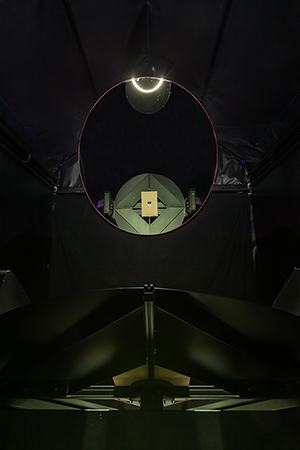 |
CARBSE’s Single Patch Sky Simulator system consists of a turntable, mirror and Fresnel lamp. By emulating one sky patch out of the total 145 virtual divisions with equal area of the sky dome, as per Tregenza’s model, a building model placed on the turntable can be rotated so that the lamp is directed from each of the sky dome’s 145 divisions, and illuminance levels can taken. These measurements are then aggregated so that they accurately reflect the daylight performance of the space under the whole sky dome. The advantage of this is that because the measurements are taken according to 145 patches, once measured physically only once, the effective sky can be altered to simulate any sky condition simply by adjusting the weightage of individual patches, and calculating the effect on the building’s illuminance levels. |
| Guarded Hot Box | |
 |
A Guarded Hot Box is used to test the thermal performance of non-homogenous specimens, such as complex wall assemblies, cavity walls, ventilated shaded wall assembly or walls with phase change materials (PCM). It determines the amount of heat transfer through a given material or assembly of various materials. This is done by controlling the temperature on both sides of the material and minimizing the extraneous heat transfers other than those through the given material, which can be used to determine the thermal transmittance of a homogenous as well as non-homogenous specimen, and can test a specimen with a maximum thickness of 350mm. The metering chamber is cooled using chiller and the guard chamber is maintained at same temperature using an HVAC system. The climatic chamber is maintained at higher temperature using electric coils. Surface, water and air temperature sensors are placed for temperature control along with humidity (RH), pressure, and air velocity sensors placed at equal distances. |
| Solar Calorimeter | |
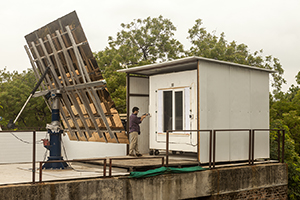 |
The solar calorimeter measures the solar gain through fenestration products. This is the fundamental test by which the solar gains through the window assembly of any such components can be measured. It can also be used for the measurement of the solar efficiency of photo voltaic cells used in Solar PV panels. The solar calorimeter is an insulated enclosure designed to permit the continuous introduction and extraction of a measured flow of fluid mass and equipped with an empty aperture into which a fenestration system is inserted for characterization. The main components of this equipment include room side metering chamber, guard chamber, surround panel for installing test specimen, calibration panel, heliostat and enclosure. |
| Thermal Comfort Chamber | |
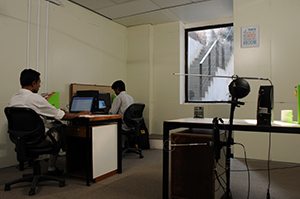 |
The Thermal Comfort Chamber (TCC) is a chamber sized 6m x 5m x 3m, which can precisely simulate a wide range of indoor environmental conditions with temperatures ranging from 15°C to 40°C and relative humidity from 16% to 95%, along with changing air distribution patterns and speed. This particular capability is useful for Indian studies because it allows researchers to measure the impact of air velocity, a necessary criteria in a context dependent on the use of fans for cooling. These conditions are maintained and monitored by sophisticated air conditioning systems and control devices. The purpose of the TCC is to conduct experiments to evaluate the impact of various indoor environmental conditions on occupant comfort, productivity, and wellbeing. People participating in the research would sit on four workstations in the TCC and experience thermal conditions set by the research team. |
| Hygrothermal Characterization Facilities | |
 |
CARBSE employs hygrothermal test facilities, which employ three types of test for material characterization. The first determines the sorption isotherm, the second derives water vapor transmission, and the third quantifies water uplift characteristics due to capillary action. The material properties derived from these tests help in calculating the water content of building materials subjected to various temperatures, pressure and RH conditions. Such characterization aids the understanding of moisture migration occurring in opaque building assemblies, which impacts structural stability, indoor air quality and energy demand for the maintenance of desired indoor conditions. |
| Lasercomp Fox 600 and NeslabTF900 Chiller | |
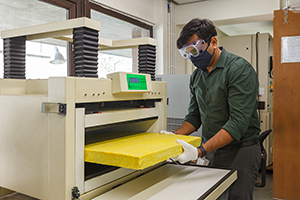 |
The lasercomp fox 600 is used to test the Thermal Conductivity and characterization of materials. The Thermal Conductivity of a specimen is determined by measuring the Heat Flux, specimen thickness, and temperature difference across the specimen. This microprocessor based instrument carry out tests according to ASTM C 518 and ISO 8301. Materials like PU Foam, Insulating Material from Industry, Thermocol, Formular, Expanded and Extruded Polystyrene, glass wool sandwiched between two plywood sheets, Styrofoam, etc. can be characterized. Specimen size 600mm x 600 mm and of thicknesses upto 200 mm are characterized for the thermal conductivity range from 0.01 to W/m.K to 0.2 W/m.K. |
| Spectrophotometer | |
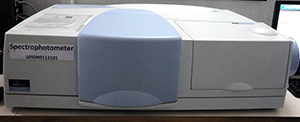 |
Spectrophotometer is a photometer (a device measuring light intensity) that can measure intensity as a function of colour (or more specifically the wavelength) of light. Spectrophotometer provides the facility for characterization of optical properties of glazing materials, architectural materials and systems of relevant to energy transfer in flat specular glazing materials. The glazing may be monolithic, coated, with applied film, laminated, etc. The Solar Absorbtence, Reflectance and Transmittance of material are determined using Spectrophotometer and Integrating Spheres. The tests are performed in accordance with EN 410 and ISO 9050. Specimen size 100mm x 100 mm and of thicknesses is compensated are tested for the optical properties. |
| Fourier Transform Infra Red Spectrometer (FTIR) | |
 |
The emissivity of glazing and architectural materials is measured in Infra Red (IR) range (Approx. 1300 nm – 44000 nm) by Fourier Transform Infra Red Spectrometer (FTIR). Fourier transform spectroscopy is a measurement technique whereby spectra are collected based on measurements of the coherence of a radiative source, using time domain or space domain measurements of the electromagnetic radiation or other type of radiation. It can be applied to a variety of types of spectroscopy (FTIR, FT-NIRS). The tests are performed in accordance with EN 673.Specimen size more than 60mm x 60mm of thicknesses is compensated are tested for emissivity. |
| Air Leakage Chamber | |
 |
Air Leakage Chamber is used to determine the air-leakage rates of windows, doors and curtain walls. NFRC 400 document based on ASTM E 283 determines the testing procedure. Air leakage chamber is not of the shelf-ready to use equipment- it needs to be constructed according to the use. The Air leakage chamber will help in evaluating the relative performance of various fenestration products. ASTM E 283 is a laboratory test method that has been used for many to measure air leakage rated under controlled conditions. Air leakage chamber will help to evaluate present construction practices as well as new improved construction practices. |
| Stand Alone Data Loggers | |
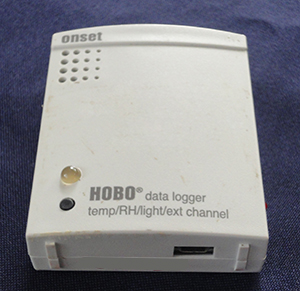 |
Data loggers are useful equipments to monitor environmental conditions inside and outside buildings. It can log data for long time (up to 3 years) at regular defined intervals for temperature, humidity, luminance and also if needed can measure CO/CO2 with additional probe. The data loggers measures the temperature range from -20° C to 70°C, Relative humidity of 5% to 95%, and light intensity from 1 to 4500 foot candles. |
| Indoor Air Quality Handheld Meters | |
 |
Indoor air quality meters can help in conducting Post Occupancy Evaluation studies as well as help in determining user perceive thermal comfort standards. These handheld meters are capable of logging as well as taking instantaneous measurements for environmental parameters |
| IAQ meter for Instantaneous measurements | |
 |
Indoor air quality meters can help in conducting Post Occupancy Evaluation studies as well as help in determining user perceive thermal comfort standards. These handheld meters are capable of logging as well as taking instantaneous measurements for environmental parameters |
| Surface Temperature Measurements RTD-PT100 | |
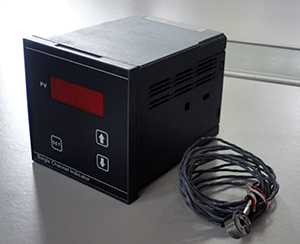 |
Basic function of the RTD sensor is to measure surface temperature. By using these RTD sensors the thermal performance of materials and thermal lag of building can be studied and understood. Experimental set up to find out the U-Value of material, assemblies and components. |
| SLR luminance measurements | |
 |
A light meter is used to measure the amount of light. It helps in conducting Post Occupancy Evaluation studies. This instrument help in color correction functions – luminance ratio and peak luminance measurements. |
| Weather Station | |
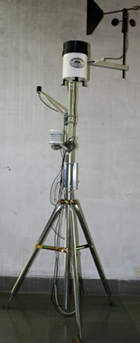 |
The micro weather station with a four-sensor data logger helps in multi channel monitoring of microclimates in one or more locations and it uses a network of smart sensors for taking measurements. Key features of the smart sensors are Automatic detection, Easy expansion, Digital network, Weatherproof. The micro sensors also helps in optimizing Lifecycle Energy Performance of commercial and residential Building (which measures temperature, RH, Rain, wind speed and direction, soil moisture, solar radiation and photosynthetic active radiation (PAR). |
| Universal light monitor | |
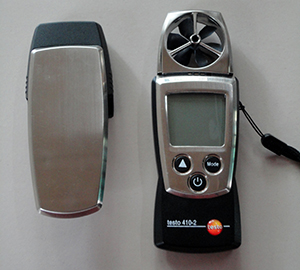 |
Light meter is used for conducting Post Occupancy Evaluation studies, daylight penetration studies and need for electric light and related energy usage in conditioned environments. These are the handheld meters capable of logging as well as taking instantaneous measurements for lux level. |
| Solar Reflectance Index (SRI) | |
|
The steady-state surface temperature (Ts) under the sun (the temperature of the surface, in K, under the standard solar and ambient conditions) is strongly correlated to solar reflectivity and thermal emissivity of the surface Solar Reflectance Index (SRI) measures the relative Ts of a surface with respect to the standard white (SRI = 100) and standard black (SRI =0) under the standard solar and ambient conditions. Where, Standard solar and ambient conditions— for the purpose of this calculation, is defined as a solar flux of 1000 W•m–2, ambient air temperature of 310 Kelvin (K), and sky temperature of 300 K. Three convective coefficient of 5, 12, 30 W•m–2•K–1, correspond to low- (0 to 2 ms–1), medium- (2 to 6 ms–1), and high-wind (6 to 10 ms 1) conditions, respectively. Standard (Reference) black surface temperature (Tb)—is the steady-state temperature of a black surface with solar reflectance of 0.05 and thermal emissivity of 0.9, under the standard solar and ambient conditions. (SRI =0) Standard (Reference) white surface temperature (Tw)—is the steady-state temperature of a white surface with solar reflectance of 0.80 and thermal emissivity of 0.9, under the standard solar and ambient conditions. (SRI = 100) |
|
| Thermal transmittance | |
|
Thermal transmittance, (sometimes called the overall coefficient of heat transfer or air-to-air U-factor): the heat transfer in unit time through unit area of a test specimen and its boundary air films, induced by unit temperature difference between the environments on each side. The U-factor is the inverse of the overall R-value. |
|

Accuracy and Precision of Data
Real-time Data & Dashboard
Battery Backup & Offline Data Storage
Easy to Install
Device Accessories
Dimensions
Warranty & Support

Sensors
| Parameter | Range | Resolution | Accuracy |
|---|---|---|---|
| PM1 / PM2.5 / PM10 | 0 - 1000 µg/m3 | 1 µg/m3 | ~ 0.8 R2 ~ MAPE 15% |
| CO2 | 0 - 10,000 ppm | 1 ppm | ±(30ppm + 3% of reading) |
| CO | 0 - 1000 ppm | 1 ppm | |
| Ozone | 10 - 1000 ppb | ||
| HCHO (Formaldehyde) | 0 - 1 ppm | 1 ppb | Greater of ± 30 ppb and ±10% of reading |
| TVOC | 0 - 10 ppm | 10 ppb | Greater of ± 30 ppb and ±10% of reading |
| Globe Temp | 0 - 100 deg C | 1 deg C | |
| Anemometer | 0 - 10 m/s | 0.1 m/s | ± 0.5 m/s |
| Ambient Pressure | 300 - 1100 hPa | 1 hPa | |
| Ambient Temp | -10 to 45 deg C | 1 deg C | ± 1.0 deg C |
| Ambient RH | 0 to 100% RH | 1% | ± 3% RH |
The team will provide additional services to develop a customised dashboard that can help to infer the field data for meaningful interventions. The analytics services also will provide insights into the indoor air quality and indoor environmental quality (thermal comfort) by mapping them against the recommended conditions by international organizations such as CIBSE, REHVA and ASHRAE.
MAPIE-Atmos Realtime Data API access
he atmos air quality data is accessible via a cloud based realtime API which provides the data in json/xml/csv formats. The format of the atmos API is as follows:
http://api.urbansciences.in/atmos-scai/mobilepm/imei/000000003107245/start/201909290000/end/201909300000/type/json/ts/hh/avg/0/ApiKey/iiitdelqygNjN
The input parameters to the API are:
/atmos-scai/mobilepm/imei/
The start and end time formats are yyyymmddhhmm
ts (time-slice): mm=minutes; hh=hours; dd=days // time-slice to be used for avg
avg:
if value is 0 = then it is raw data
if value is 1,2,3,.. = avg period for time-unit given in above time-slice
The output data of the API are:
{"list":[{"pm1cnc":18.0,"pm1cnt":102.0,"pm25cnc":23.0,"pm25cnt":12.0,"pm10cnc":25.0,"pm10cnt":
2.0,"pm03cnt":2487.0,"pm05cnt":805.0,"pm5cnt":3.0,"no2op1":0.0,"no2op2":0.0,"o3op1":
0.0,"o3op2":0.0,"temp":27.0,"humd":35.0,"pres":980.0,"lat":28.4500686301341,"lon":
77.2840768294724,"imei":"000000001698051","timeStamp":"2019-09-30T16:00:03.000+05:30","time":1569839403000},{"pm1cnc":19.0,"pm1cnt":90.0,"pm25cnc": 23.0,"pm25cnt":10.0,"pm10cnc":24.0,"pm10cnt":0.0,"pm03cnt":2541.0,"pm05cnt":
825.0,"pm5cnt":1.0,"no2op1":0.0,"no2op2":0.0,"o3op1":0.0,"o3op2":0.0,"temp":27.0,"humd":
35.0,"pres":980.0,"lat":28.4500686301341,"lon":77.2840768294724,"imei":"000000001698051",
"timeStamp":"2019-09-30T16:00:08.000+05:30","time":1569839408000},
Click to download brochure : MAPIE Atmos: Indoor Thermal Comfort and Air Quality Measurement Kit